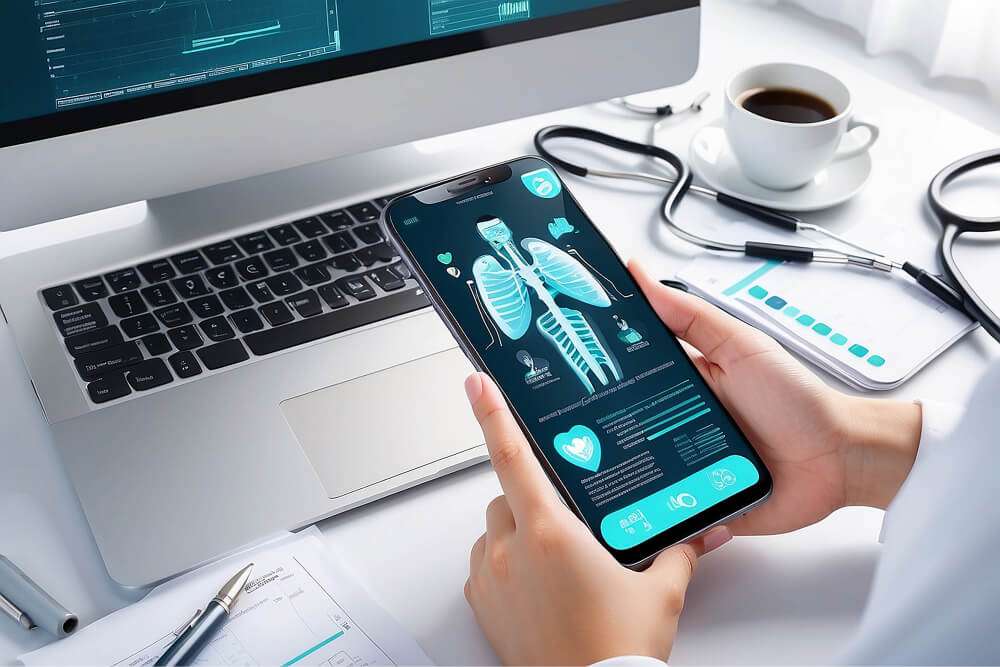The rapid pace of technological change is transforming healthcare on what seems like a daily basis, with new surgical techniques, biometric monitors, diagnostic tools, or prosthetic devices a common sight on news websites. But technologically enhanced treatment is only one aspect of this new age of healthcare.
How Technology Benefits Your Patients Beyond Treatment

In this 5-minute read we’ll explore:
- Innovations in patient-provider communication
- Digital patient education and engagement
- The role of technology in personalized care
- Overcoming obstacles to digital transformation
- How patient-centered healthcare may look in the future
Looking beyond the clinical setting, the industry has undergone a similar transformation with the advent of digital and web-based communications — and this is particularly evident in how technology has reshaped communication between patients and providers.
Rigid, provider-led communication methods are being replaced by more dynamic, technology-driven solutions, guided and shaped by patient preference.
This transition presents the opportunity for more efficient, engaging, and effective interactions, which in turn have a positive impact on patient care and provider efficiency.
The evolution of healthcare communication
Over the last decade or so, healthcare communication has experienced a paradigm shift: from traditional face-to-face interactions and paper-based processes to digital alternatives. And the pace of change continues to accelerate.
Today’s patients are looking for more from their healthcare providers in terms of communication — prioritizing quality, flexibility, and convenience in their interactions. HCPs must be prepared to “meet them where they are”, incorporating new channels such as messaging apps, video conferencing, or social media accounts.
The ubiquity of smartphones and the internet means patients expect to easily access healthcare information and services on demand. This creates a valuable opportunity for providers to offer detailed resources that proactively address common queries and issues, leading to more efficient care.
In terms of communicating patient data, digital platforms such as Electronic Health Records (EHRs), have become the backbone of healthcare information management, enabling quick and secure access to patient data, and improving efficiency and accessibility in healthcare delivery.
Innovations in patient-provider communication
Technologically literate patients expect their access to healthcare to be just as convenient as other digitally-enabled services such as banking, shopping, or travel. To meet their demands, healthcare providers have a range of recent innovations at their disposal.
- Patient portals: allow patients to access medical records, schedule appointments, and communicate with providers online, reducing the volume of inbound calls or emails to providers and maintaining a single source of data.
- Telehealth platforms: allow healthcare professionals to offer remote consultations, removing geographical barriers and making healthcare more accessible for patients with mobility or anxiety issues.
- Mobile health apps: offer personalized health reminders, medication tracking, and lifestyle management tools, significantly enhancing patient engagement and facilitating preventative care.
- Wearables: including smartwatches and fitness trackers, allow health data to be recorded and shared with HCPs without the need for an onsite appointment.
- AI chatbots: can be programmed to provide a first response to common health questions without the need to involve a CX agent, and intelligently route the conversation to the most appropriate department if human input is needed.
- Smart CRMs: can use AI and machine learning to support CX teams by providing them with valuable contextual information during each patient interaction, based on case history or previous communications.
Behind-the-scenes technologies such as staff mobile apps and scheduling tools also play a crucial supporting role in streamlining operations and improving communication efficiency within healthcare facilities. On a macro level, smart hospital management systems can track bed occupancy, pharmaceutical inventory, staffing schedules, equipment status, and much more.
While less visible in terms of the patient experience, these tools have a tangible impact in terms of resource management, record-keeping and data sharing, informing customer care flows, and ensuring that patients receive timely and effective care.

Enhancing patient engagement and education
The unprecedented amount of information that can now be gathered by these types of interfaces and devices presents another opportunity for healthcare providers — building detailed patient profiles and leveraging that data to personalize healthcare in new ways.
Each patient’s health journey is unique, and personalized care plans ensure that treatment and communication are tailored to meet individual needs — crucial in delivering truly patient-centric care. Technology has a key role to play here too, as the overwhelming volumes of data generated by patient interactions are too unmanageable for even the most well-resourced teams to unravel.
However, today’s AI solutions can ingest, categorize, and analyze multiple data streams to provide CX teams with actionable insights at a group or individual patient level.
They can answer simple requests or questions automatically, alert medical staff to any mention of health problems, and provide patients themselves with detailed reports incorporating the entirety of their healthcare journey.
With the easily available insights into patient preferences, history, and behavior, available through AI-powered solutions, healthcare and CX staff can focus on their interpersonal communication and engagement strategies. This combination of hi-tech analysis and human empathy to deliver a level of personalized care not previously possible not only improves patient satisfaction but also enhances the overall effectiveness of healthcare delivery.
Challenges and considerations
One of the primary challenges in implementing new technology in healthcare is ensuring patient data privacy and protection. With the increasing use of digital tools and platforms, healthcare providers must adhere to stringent data security regulations and adopt robust cybersecurity measures to safeguard patient information — as well as ensure staff using these tools are properly trained in data protection measures.
The digital divide poses another set of challenges. While younger generations are generally receptive to new technologies and able to learn how to use them quickly, older patients may find it difficult to navigate health platforms and other digital tools. Accessibility is key here, as is implementing any transition gradually. For true inclusivity, providers need to implement user-friendly interfaces and offer comprehensive training and support — ensuring patients can benefit from new digital initiatives as equally as possible.
Encouraging adoption internally can also present a barrier — the digital skills of clinicians, administrative staff, or CX agents may vary to the same extent as those of their patients. Organizations need to plan any transition carefully, ensuring sufficient time and support are available to onboard staff, and present the incoming solutions in a way that makes the ultimate benefits clear, to ensure buy-in.

The future of patient-provider communication
Innovations in artificial intelligence, augmented reality, and more sophisticated telehealth solutions will continue to revolutionize how healthcare providers communicate with their patients at every stage of the healthcare journey — along with new technologies not yet in their infancy.
In the near future, AI-powered algorithms have the potential to enable even more tightly personalized treatment plans by analyzing vast amounts of health data and making informed recommendations to medical staff. Augmented reality promises more interactive and engaging patient education, as well as enhanced training for healthcare professionals. Ever-evolving communications platforms incorporating high-definition video and virtual reality open up the possibility that remote diagnosis, not just remote consultancy, could become the norm.
By continuing to leverage cutting-edge technology as it emerges, healthcare providers can offer more accurate diagnoses, more effective treatments, and more personalized patient care plans. This not only leads to better health outcomes but also enhances the overall patient experience — increasing patient loyalty and trust. Staying ahead of the game in technology adoption is therefore key to maintaining competitiveness and profitability in an increasingly digital healthcare landscape.
Conclusion
Technology is an integral part of enhancing patient outcomes — and a critical component of a comprehensive CX strategy in a healthcare setting. From facilitating better patient education and engagement to personalizing patient care, well-integrated technology offers multiple benefits — assisting and enhancing the human aspect of healthcare that remains crucial to patient satisfaction and care. Blending technological advancements with personalized, patient-centered care, healthcare providers can ensure a high-quality patient experience across all aspects of healthcare — from educative and preventative initiatives to enhanced clinical outcomes to functional interactions with administrative teams. By doing so, they position themselves for success in a highly competitive and rapidly evolving healthcare landscape.



 How Technology Benefits Your Patients Beyond Treatment
How Technology Benefits Your Patients Beyond Treatment


